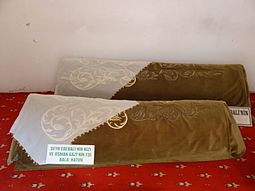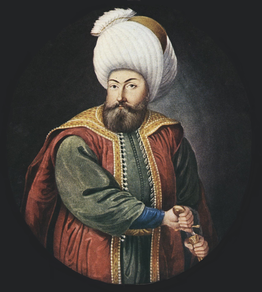Rabia Bala Hatun
Rabia Bala Hatun | |
|---|---|
 | |
| Born | Rabia 11th century |
| Died | January 1324 |
| Resting place | Tomb of Sheikh Edebali, Bilecik, Turkey |
| Spouse | Osman I |
| Children | Alaeddin Pasha |
| Parent | Sheikh Edebali |

Rabia Bala Hatun (died January 1324[1] birth name Rabia) was the wife of Ottoman Sultan Osman I. She was the daughter of the famous Sheikh, Edebali and the mother of Alaeddin Pasha of the Ottoman Empire.[2]
Names
The fact that Edebali's daughter is called by different names in the sources, Rabia and Bala, suggests that these may have been the names of other wives.[3] Sheikh Edebali's daughter is referred to as "Rabia" in the history of Uruc, and as "Malhun" in those of Aşıkpaşazade and Neşri.[3] The latter tradition has proved dominant, and Orhan's mother Mal Hatun, the daughter of Ömer Abdülaziz Bey, is commonly thought to be Sheikh Edebali's daughter.[3] The new researches prove that the daughter of Sheikh Edebali was "Rabia Bala Hatun".
Early life
Rabia Bala Hatun was born as the daughter of Sheikh Edebali, a descendant of Banu Tamim tribe (Arabic: بنو تميم) and the Al Khater / Khater (Arabic: خاطر) family.[3] According to a legend, after Osman's first local victories over neighbouring Byzantine lords, he had a dream the meaning of which was obscure to him. In this dream, a moon rose from the breast of a widely revered dervish sheikh, Edebali, and entered Osman's own breast.[3] From Osman's naval sprang a tree, which grew to shade the entire world.[3] Under the branches of the tree were mountains, from which flowing water served to quench the thirst of some and to irrigate the Fields of others.[3] When Osman sought Edebali to learn the meaning of the dream, the sheikh told him that it signified God's grant of sovereignty to him and his descendants.[3] The moon, explained Edebali, represented his own daughter, to whom Osman was forthwith united in marriage.[3]
Marriage to Osman
The marriage of Osman and Rabia Bala Hatun actually occurred in 1289, if not by divine design.[3] From the central government records regarding the property she received at the time of her marriage; the village of Kozağaç in the district of Belicik, where the dervish hospice of her father was located.[3] Edebali was one of the influential of popular religious leaders in the Ottoman territories.[3] In Central Asian Mongol and Turkish tradition, holy men were typically the vehicle of transmission of God's choice of the bearers of sovereignty.[3] The story of Osman's marriage to Rabia Bala Hatun was a manifestation of the importance of this internal basis of dynastic legitimization in the early Ottoman state; hence it was encoded in the most popular of dynastic foundation myths.[3]
The success of the early Ottoman military enterprise, as well as the conversion of large numbers of Balkan Christians, were due in no small degree to the spiritual authority of dervish leaders such as Edebali.[3] Their hostels and monasteries formed the nuclei for settlements that grew into towns and garrison centers, and they infused a religious zeal into war against the "infidel" through their participation in military campaigns.[3] Osman's marriage to Rabia Bala Hatun was perhaps the first example of the dynasty's attentive nurturing of its ties with these holy men.[3]
Death and burial
She died in 1324. Although, she preceded her husband, Osman, she was buried with her father in Belicik, perhaps because no thought had yet been given to an appropriate location for an imperial tomb.[3]
See also
Further reading
- Peirce, Leslie P., The Imperial Harem: Women and Sovereignty in the Ottoman Empire, Oxford University Press, 1993, ISBN 0-19-508677-5 (paperback).
- Yavuz Bahadıroğlu, Resimli Osmanlı Tarihi, Nesil Yayınları (Ottoman History with Illustrations, Nesil Publications), 15th Ed., 2009, ISBN 978-975-269-299-2 (Hardcover).
References
- ^ "Turkey: The Imperial House of Osman". web.archive.org. Retrieved 6 February 2014.
- ^ Ahmed Akgündüz, Said Öztürk (2011). Ottoman History: Misperceptions and Truths. Oxford University Press. ISBN 978-9-090-26108-9.
- ^ a b c d e f g h i j k l m n o p q r Leslie P. Peirce (1993). The Imperial Harem: Women and Sovereignty in the Ottoman Empire. Oxford University Press. pp. 106–107. ISBN 978-0-195-08677-5.

